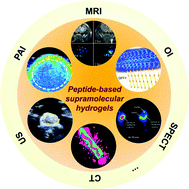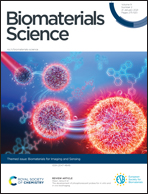Peptide-based supramolecular hydrogels for bioimaging applications
Abstract
Owing to their superior loading capacity and biocompatibility, imaging agent-conjugated (or encapsulated) peptide-based supramolecular hydrogels are capable of imaging in vivo biological events with enhanced signals. Notably, by rational design of the hydrogelators, the hydrogelation process can “smartly” occur on the pathological site (or region of interest), rendering precise and sensitive bioimaging of the disease (or event) in vivo. Considering their importance in disease diagnosis, herein, we provide a review on the recent advances in peptide-based supramolecular hydrogels for bioimaging applications. Besides, we provide an outlook on the challenges (or chances) for these types of biomaterials in the field of bioimaging.

- This article is part of the themed collection: Biomaterials for Imaging and Sensing


 Please wait while we load your content...
Please wait while we load your content...